The Recirculation Zone Characteristics of the Circular Transverse Jet in Crossflow
Abstract
1. Introduction
2. Turbulence Model Selection and Analysis
2.1. Theoretical Analysis of Turbulence Models
2.2. Modeling and Grid Generation
2.3. Numerical Simulation Results and Comparison with Experimental Data
2.3.1. Comparison of Velocity Field Distribution under Four Turbulence Models
2.3.2. Jet Trajectories under Four Turbulence Models and Comparison with Experimental Results
- For xmax, the result of calculation by the k-ε Realizable model is the largest, by RSM model is the second, and by the k-ε standard model is the smallest; for ymax, the results of calculation by RSM model is the largest, by the k-ε Realizable model is the second, and by the k-ε standard model is the smallest.
- The results of calculation by the k-ε Realizable and RSM are both larger than the experimental values. The calculation results of the SST k-ω turbulence model are closest to the experimental values. The results of the k-ε standard model are smaller than the experimental values. The deviations of xmax and ymax under the k-ε standard model are 4% and 11.1%, respectively. The results of the SST k-ω turbulence model are close to the experimental values. The relative deviations of and ymax calculated by the SST k-ω turbulence model are 1.3% and 0% to the experimental values, respectively. While the relative deviations of xmax and ymax calculated by the k-ε Realizable model are 27.0% and 11.1%, the relative deviations of xmax and ymax calculated by the RSM linear pressure–strain model are 20.6% and 33.3%. It can be seen that when q = 30, the calculation results of the turbulence model SST k-ω are in the best agreement with the experimental results.
3. Flow Structure and Aerodynamic Characteristics
3.1. Research on Flow Field Structure
3.2. Research on Flow Field Characteristics
4. Conclusions
- For the circular transverse jet, the numerical results calculated by the SST k-ω model is best consistent with the experimental results. Turbulence model SST k-ω is the best suitable model for the numerical simulation of the circular transverse jet among these four calculated turbulence models (k-ε standard, k-ε Realizable, SST k-ω, and RSM).
- In the flow field, under the interaction of the circular transverse jet with the crossflow, an axial symmetric negative pressure zone is formed behind the jet trajectory, and there exists an axial symmetric vortex structure due to the sucking effect of the negative pressure zone. This structure causes the reverse flow of the fluid behind the jet trajectory, forming a typical recirculation zone. Since the existence of the recirculation zone playing an important role in flame stabilization, the circular transverse jet would be a potential method for the stable combustion system.
- Through the comparison of multiple groups of numerical results, it is found that the recirculation zone formed by the interaction of the circular transverse jet with crossflow has a constant length/width ratio. It means that the shape of the recirculation zone is not affected by the crossflow and jet parameters under the condition of unchanging geometric sizes of jet devices.
Author Contributions
Funding
Acknowledgments
Conflicts of Interest
References
- Nair, V.; Wilde, B.; Emerson, B.; Lieuwen, T. Shear Layer Dynamics in a Reacting Jet in Crossflow. Proc. Combust. Inst. 2019, 37, 5173–5180. [Google Scholar] [CrossRef]
- Panda, P.P.; Busari, O.; Roa, M.; Lucht, R.P. Flame stabilization mechanism in reacting jets in swirling vitiated crossflow. Combust. Flame 2019, 207, 302–313. [Google Scholar] [CrossRef]
- Huang, R.F.; Kimilu, R.K.; Hsu, C.M. Effects of jet pulsation intensity on a wake-stabilized non-premixed jet flame in crossflow. Exp. Therm. Fluid Sci. 2016, 78, 153–166. [Google Scholar] [CrossRef]
- Smith, S.H.; Mungal, M.G. Mixing, structure and scaling of the jet in crossflow. J. Fluid Mech. 1998, 357, 83–122. [Google Scholar] [CrossRef]
- Moussa, Z.M.; Trischka, J.W.; Eskinazi, S. The nearfield in the mixing of a round jet with a cross-stream. J. Fluid Mech. 1977, 80, 49–80. [Google Scholar] [CrossRef]
- Karagozian, A.R. Transverse jets and their control. Prog. Energy Combust. Sci. 2010, 36, 531–553. [Google Scholar] [CrossRef]
- Wagner, J.A.; Grib, S.W.; Renfro, M.W.; Cetegen, B.M. Flowfield measurements and flame stabilization of a premixed reacting jet in vitiated crossflow. Combust. Flame 2015, 162, 3711–3727. [Google Scholar] [CrossRef]
- Rugger, R.; Callaghan, E.; Bowden, D. Penetration of air jets issuing from circular, square and elliptic orifices directly perpendicularly to an air stream. NACA TN. 2019. Available online: http://naca.central.cranfield.ac.uk/report.php?NID=4008 (accessed on 9 June 2020).
- Keffer, J.; Baines, W.D. The round turbulent jet in a cross-wind. J. Fluid Mech. 1962, 15, 481–496. [Google Scholar] [CrossRef]
- Kamotani, Y.; Greber, I. Experiments on a turbulent jet in a cross flow. AIAA J. 1972, 10, 1425–1429. [Google Scholar] [CrossRef]
- Fric, T.F.; Roshko, A. Vortical structure in the wake of a transverse jet. J. Fluid Mech. 1994, 279, 1–47. [Google Scholar] [CrossRef]
- Kelso, R.M.; Lim, T.T.; Perry, A.E. An experimental study of round jets in cross-flow. J. Fluid Mech. 1996, 306, 111–144. [Google Scholar] [CrossRef]
- Yuan, L.L.; Street, R.L. Trajectory and entrainment of a round jet in crossflow. Phys. Fluids 1998, 10, 2323–2335. [Google Scholar] [CrossRef]
- Cortelezzi, L.; Karagozian, A.R. On the formation of the counter-rotating vortex pair in transverse jets. J. Fluid Mech. 2001, 446, 347–373. [Google Scholar] [CrossRef]
- Muppidi, S.; Mahesh, K. Direct numerical simulation of round turbulent jets in crossflow. J. Fluid Mech. 2007, 574, 59–84. [Google Scholar] [CrossRef]
- Huang, R.F.; Hsieh, R.H. Sectional flow structures in near wake of elevated jets in crossflow. AIAA J. 2003, 41, 1490–1499. [Google Scholar] [CrossRef]
- Kosterin, V.A.; Rogozhin, B.A.; Dudkin, V.T. Calculation of a combustion chamber with flame stabilizers. Burn. Stream 1970, 141–159. [Google Scholar]
- Lebedev, B.P.; Kosterin, V.A.; Gordon, M.S.; Zikeev, V.S.; Nosov, L.A. Aerodynamic Stabilization of Flame in Afterburners; Proceedings of CIAM: Moscow, Russia, 1977. [Google Scholar]
- Qiu, H.; Zhang, J.; Sun, X.; Chang, J.; Bao, W.; Zhang, S. Flowing residence characteristics in a dual-mode scramjet combustor equipped with strut flame holder. Aerosp. Sci. Technol. 2020, 99, 105718. [Google Scholar] [CrossRef]
- Song, X.; Zhang, M. Turbulent Drag Reduction Characteristics of Bionic Nonsmooth Surfaces with Jets. Appl. Sci. 2019, 9, 5070. [Google Scholar] [CrossRef]
- Demena, A.M. Development of Methodological Foundations of Gas-Dynamic Flame Stabilization for Combustion Chambers on Swirling High-Enthalpy Jets. 2008. Available online: https://www.dissercat.com/content/razrabotka-metodicheskikh-osnov-gazodinamicheskoi-stabilizatsii-fronta-plameni-potochnykh-ka (accessed on 9 June 2020).
- Zhao, F.; Zhang, Y.; Zhu, R.; Wang, H. Turbulence model in supersonic jet flow field. J. Univ. Sci. Technol. Beijing 2014, 36, 366–371. [Google Scholar]
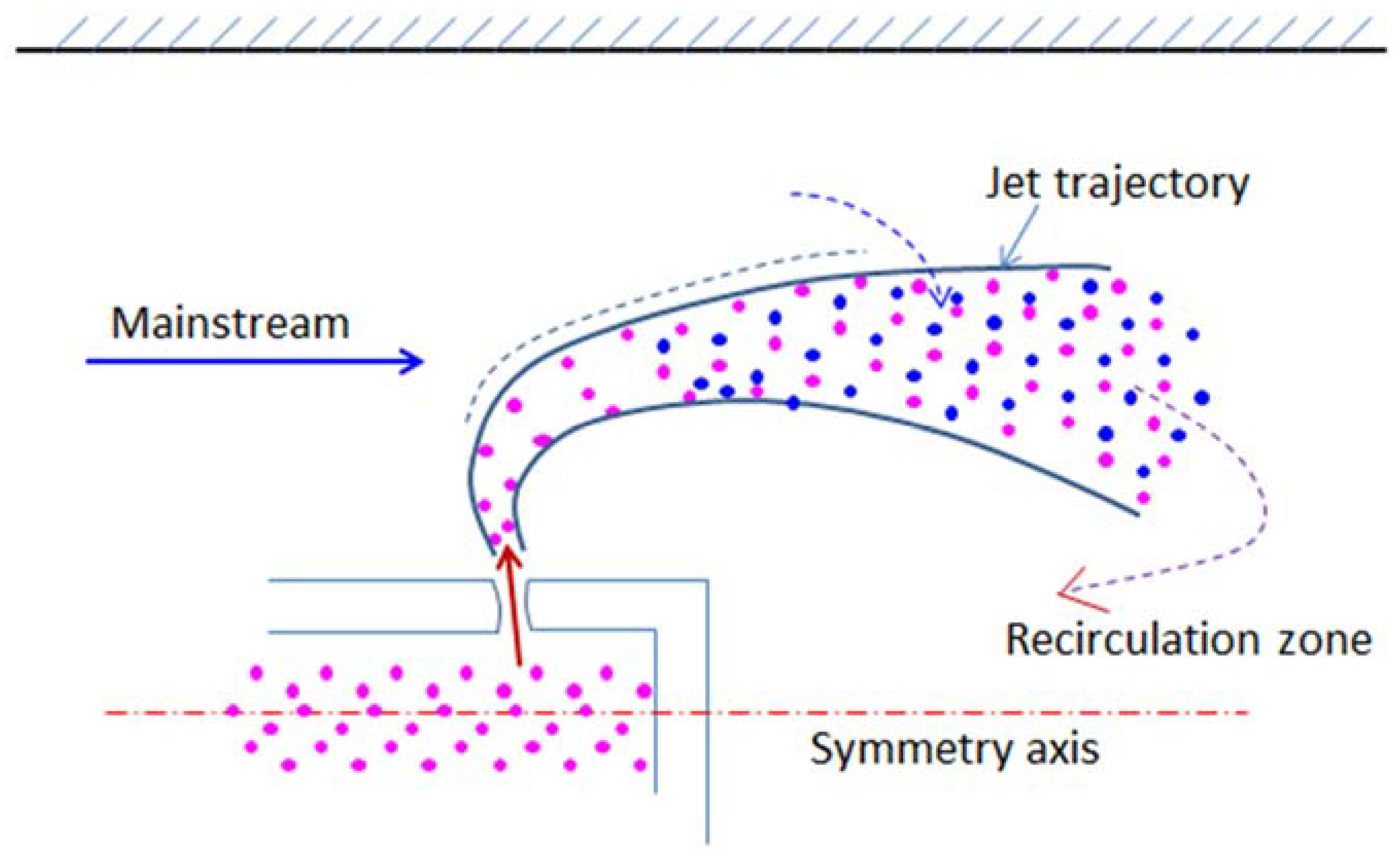
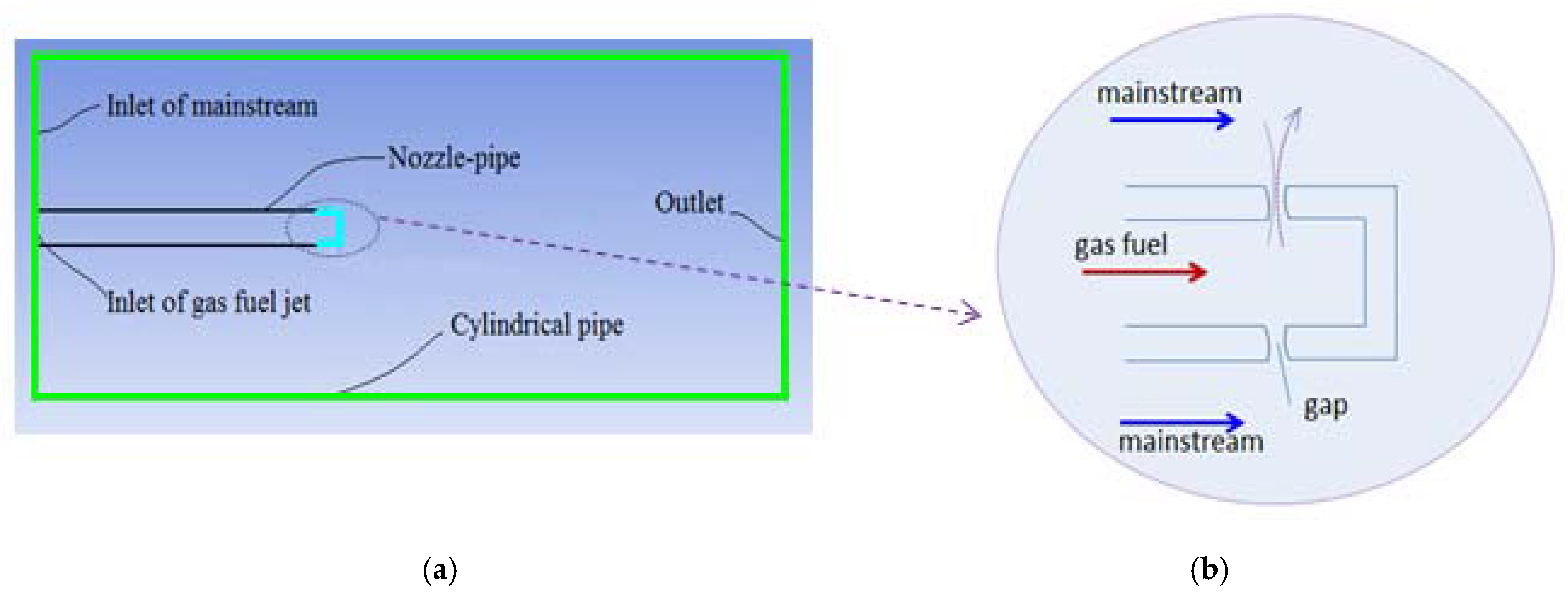

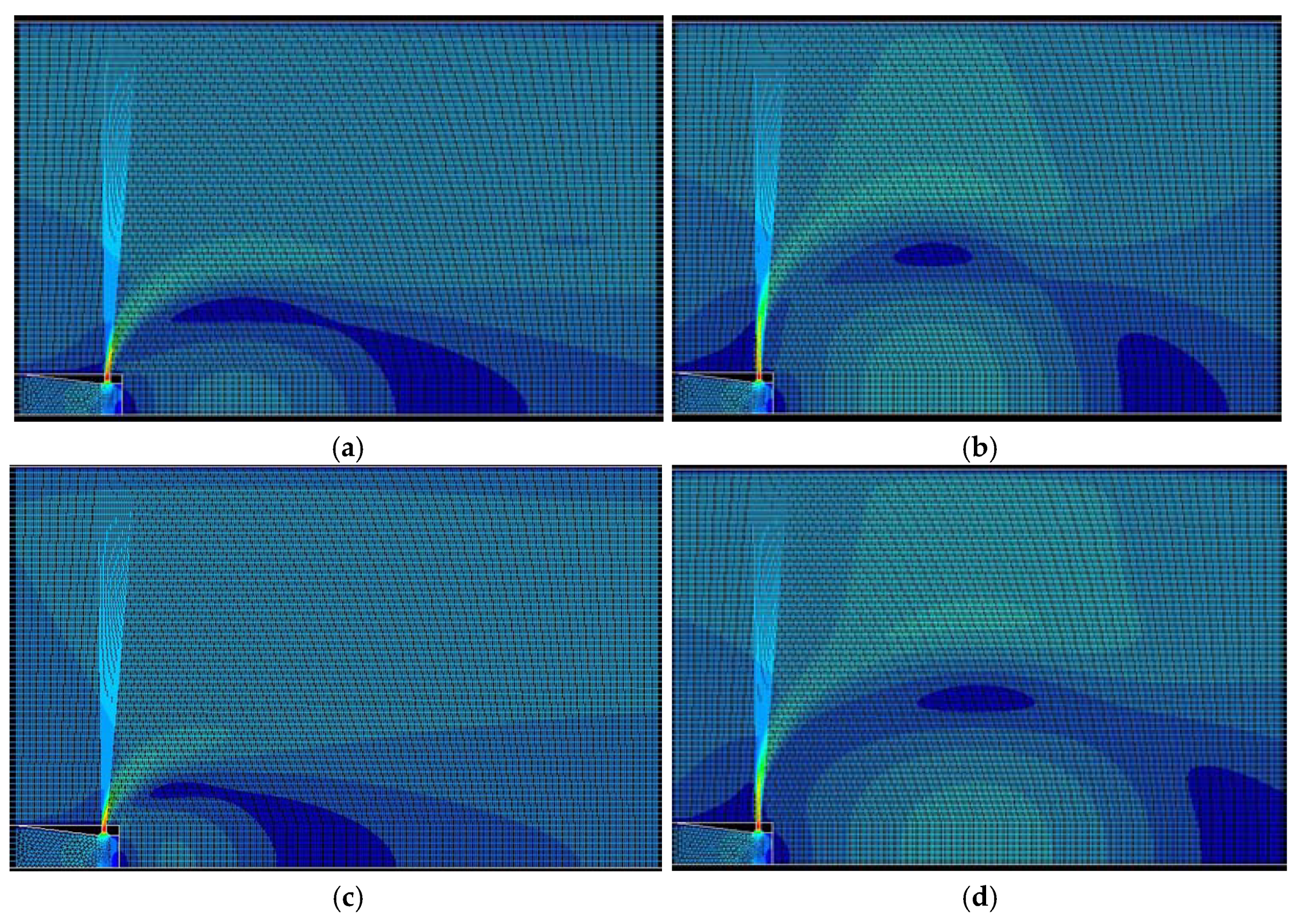
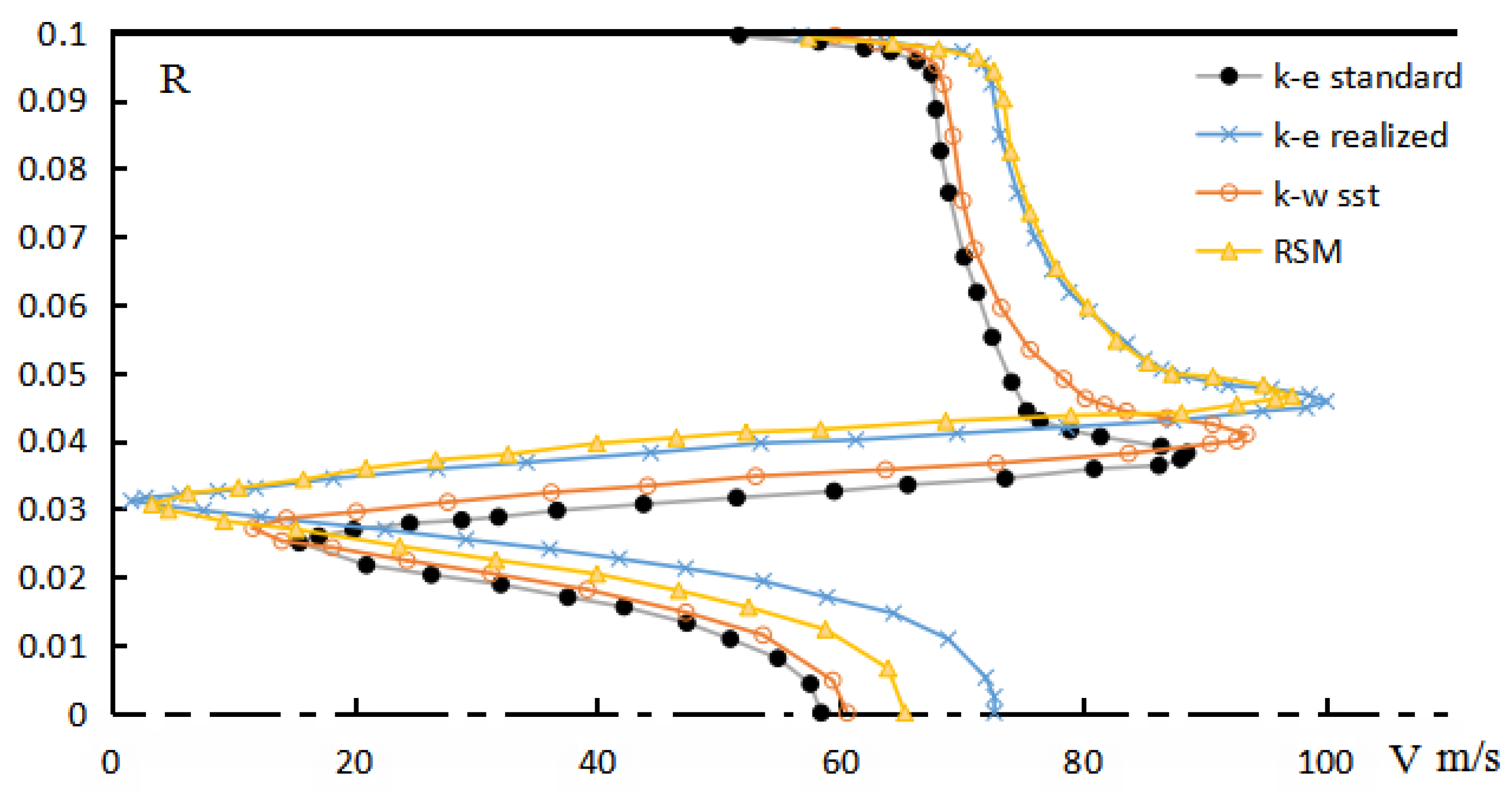
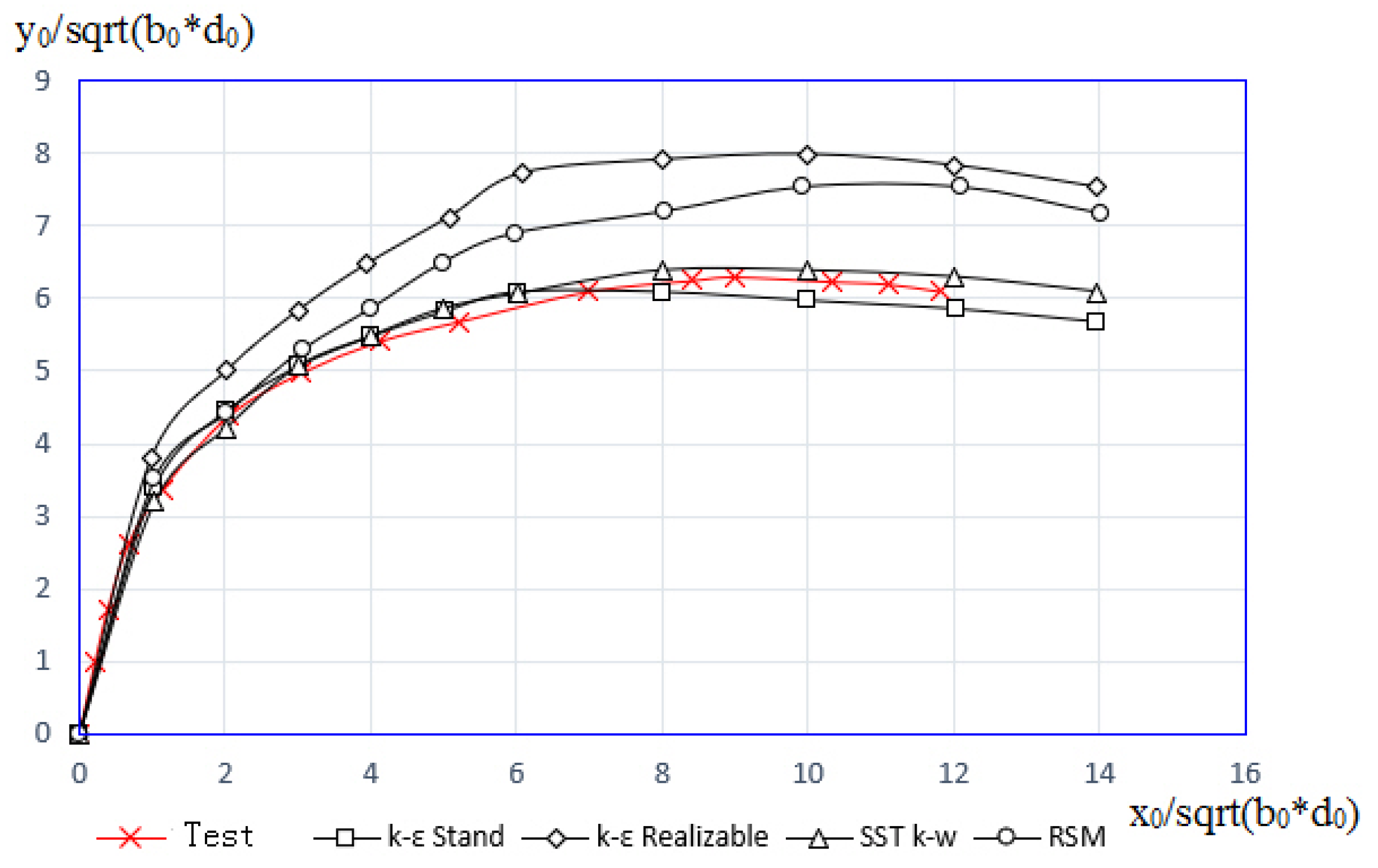
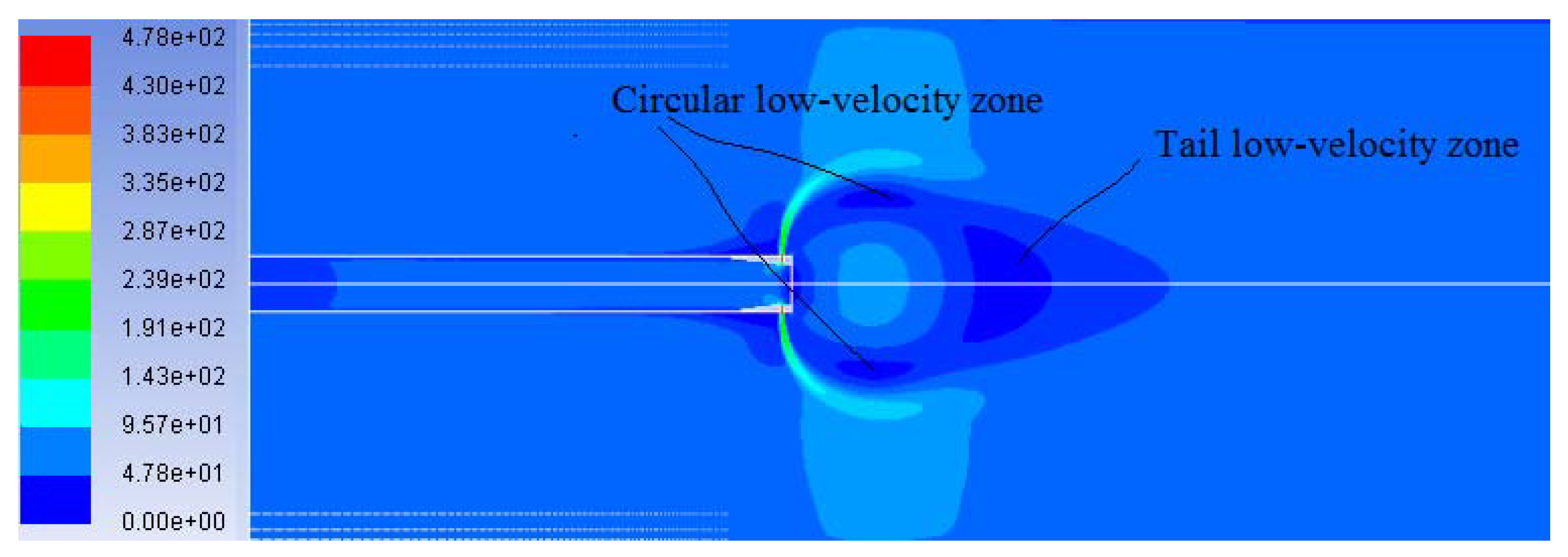
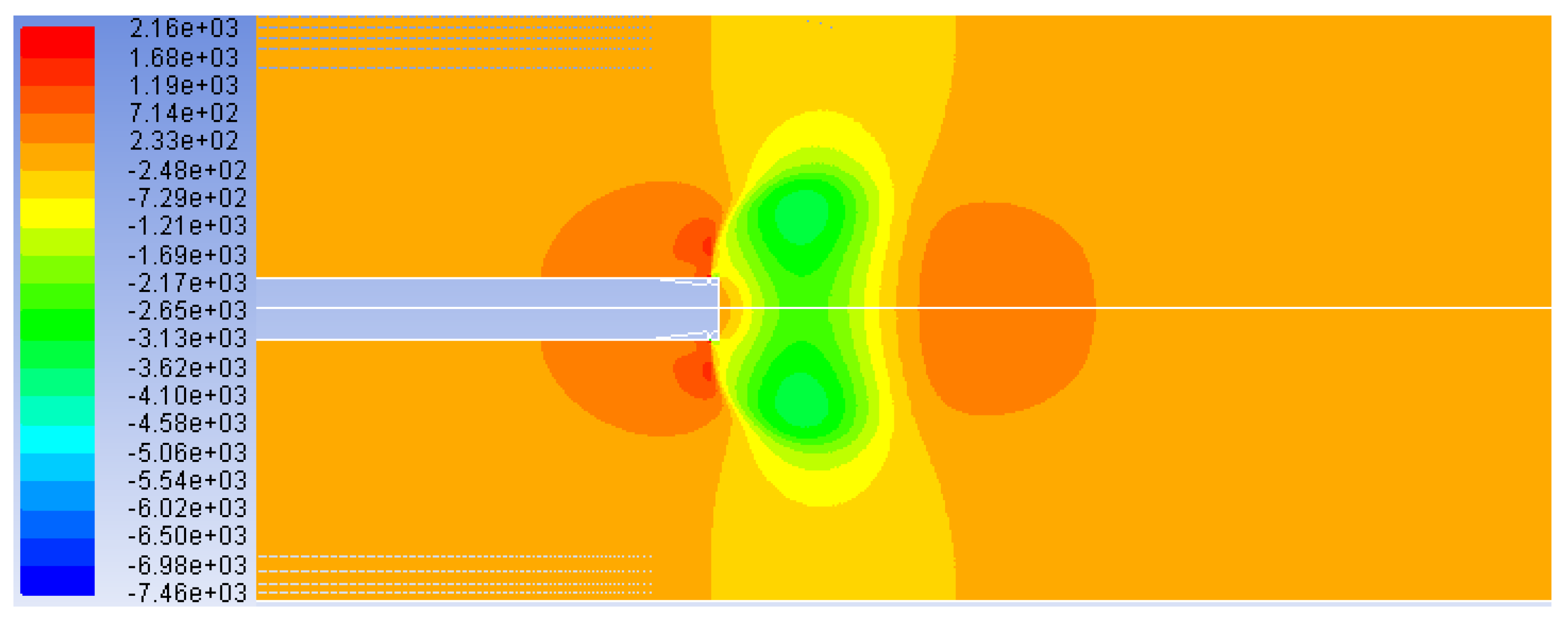


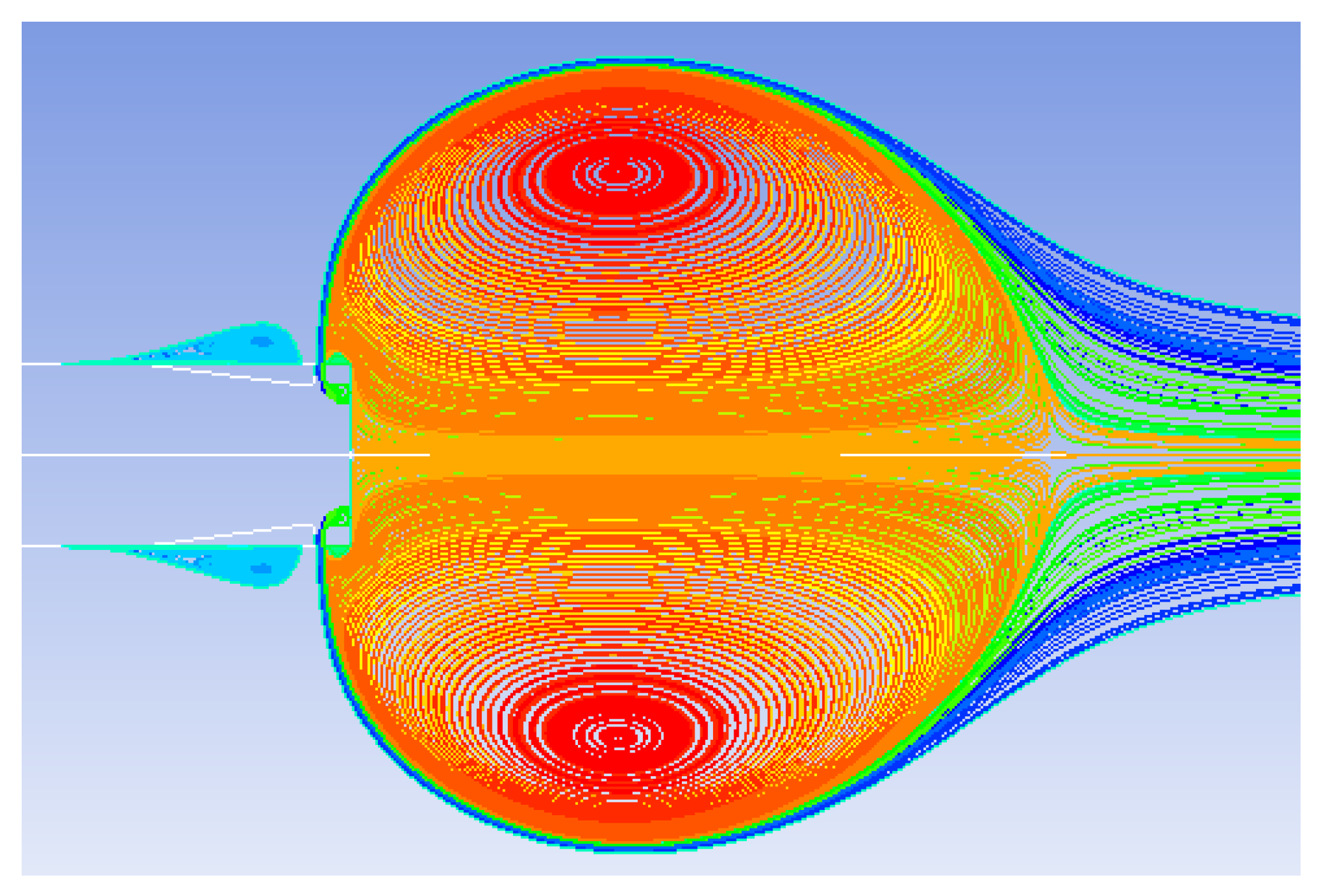


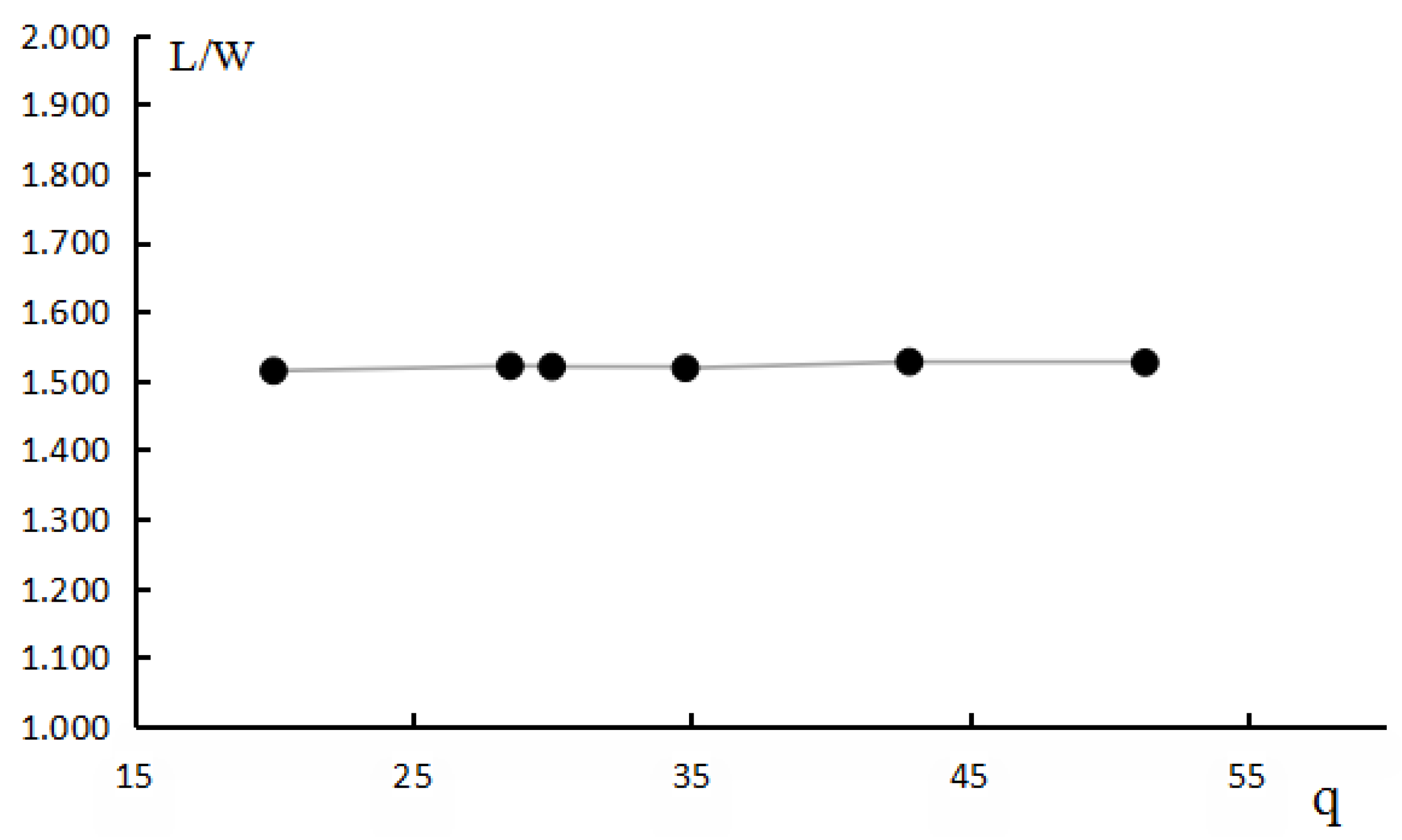
| Models | Transport Equations | Applicable Ranges and Characteristics [22] |
|---|---|---|
| standard k-ε | (1) (2) | The semiempirical model, assuming that the whole flow field is turbulent, neglects the influence of molecular viscosity, shows good stability, economy, and rationality in a wide range of turbulent flow. |
| Realizable k-ε | (3) (4) | Different turbulent viscosity formulas are used. The model does well in the simulation of the expansion rate of the plane and cylinder jet, and boundary layer under the condition of strong reverse pressure gradient and separated flow. |
| SST k-ω | (5) (6) | A mixing function is introduced into the boundary layer, and a damping cross-diffusion term is introduced into the ω equation. The turbulent viscosity is also modified to explain the turbulent shear force, so that it has a higher accuracy and a wider application environment. |
| RSM | (7) | It is the RANS model that most conforms to the physical mechanism. The isotropic eddy viscosity hypothesis is avoided. It takes up more CPU time and memory. It is difficult to converge and suitable for complex 3D flow (such as curved pipe, rotation, swirl combustion, swirl separator, etc.) |
| Turbulence Model | k-ε Standard | k-ε Realizable | SST k-ω | RSM | Test Value |
|---|---|---|---|---|---|
| xmax | 6.05 | 8 | 6.38 | 7.6 | 6.3 |
| ymax | 8 | 10 | 9 | 12 | 9 |
| Airflow rate in jet, kg/s | 0.0165 | 0.018 | 0.019 | 0.020 | 0.022 | 0.024 |
| Airflow rate in mainstream, kg/s | 1.39 | |||||
| momentum ratios, q | 20 | 28.50 | 30 | 34.80 | 42.85 | 51.32 |
| Mach number at the exit of gap, M | 0.617 | 0.771 | 0.812 | 0.874 | 0.989 | 1 |
| Length of recirculation zone, L, m | 0.0778 | 0.084 | 0.086 | 0.089 | 0.099 | 0.102 |
| Width of recirculation zone, W, m | 0.0514 | 0.055 | 0.0565 | 0.059 | 0.065 | 0.068 |
| L/W ratio | 1.514 | 1.521 | 1.52 | 1.518 | 1.527 | 1.526 |
© 2020 by the authors. Licensee MDPI, Basel, Switzerland. This article is an open access article distributed under the terms and conditions of the Creative Commons Attribution (CC BY) license (http://creativecommons.org/licenses/by/4.0/).
Share and Cite
Li, Z.; Yuan, Y.; Guo, B.; Varsegov, V.L.; Yao, J. The Recirculation Zone Characteristics of the Circular Transverse Jet in Crossflow. Energies 2020, 13, 3224. https://doi.org/10.3390/en13123224
Li Z, Yuan Y, Guo B, Varsegov VL, Yao J. The Recirculation Zone Characteristics of the Circular Transverse Jet in Crossflow. Energies. 2020; 13(12):3224. https://doi.org/10.3390/en13123224
Chicago/Turabian StyleLi, Ziwan, Yixiang Yuan, Baoting Guo, V. L. Varsegov, and Jun Yao. 2020. "The Recirculation Zone Characteristics of the Circular Transverse Jet in Crossflow" Energies 13, no. 12: 3224. https://doi.org/10.3390/en13123224
APA StyleLi, Z., Yuan, Y., Guo, B., Varsegov, V. L., & Yao, J. (2020). The Recirculation Zone Characteristics of the Circular Transverse Jet in Crossflow. Energies, 13(12), 3224. https://doi.org/10.3390/en13123224




